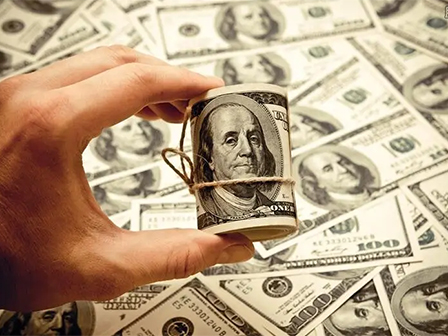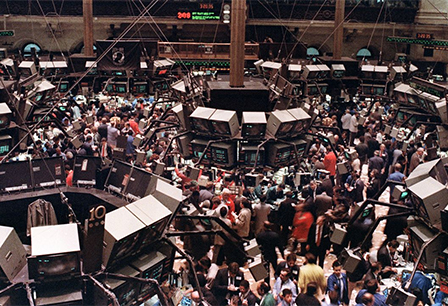It’s taken financial markets almost four months to register the likelihood that U.S. interest rates could rise above 5% by March, the highest level since 2006, but that moment may finally be arriving.
The bond market was one of the first places to display this realization: On Thursday, rates on 6-month TMUBMUSD06M, 4.841% and 1-year Treasury bills TMUBMUSD01Y, 4.831% jumped above 4.8%, accompanied by a rise in most yields across the Treasury curve. Meanwhile, fed funds futures traders briefly bumped up the likelihood of a 5%-plus fed-funds rate target in the next two months, to 41% from 25% on Wednesday.
Financial markets, usually quick to size up developments worldwide, have taken more than a few moments to absorb the reality of the current U.S. inflation environment, which includes the need for continued higher interest rates to combat stubborn inflation despite glimmers of progress in bringing down price gains. Inflation, which came in at 7.1% in November based on the annual headline rate from the consumer price index, has dropped for five straight months after peaking at 9.1% in June, yet Fed officials remain resolute. They’ve even pushed back forcefully on the market’s assumptions about how policy makers ought to be setting rates.
“Old habits die hard,” said Rob Daly, director of fixed income at Glenmede Investment Management in Philadelphia, which oversees $4.5 billion of fixed-income assets. “Sometimes the market takes a long time to adjust to a new reality and we are in this new reality of a higher inflationary environment — not as high as it was, but not 2% either — and a higher interest-rate regime without the fiscal or monetary backstop we’ve had in the past.”
“The market has been waking up,” particularly after the minutes of the Fed’s December meeting, recent remarks by policy makers, and continued strong labor data, Daly said via phone Thursday. “The Fed has more wood to chop and investors are getting used to the reality that they need to continue to batten down the hatches and be cautious.”
The prospect of a 5% fed-funds rate has existed since September and October, when Deutsche Bank DB, -2.72% and Barclays BARC, -0.41% each called out the possibility. In November, though, Fed Chairman Jerome Powell interrupted the Treasury bill market’s march toward 5%, by saying that the pace of rate hikes might begin to slow by the following month.
Meanwhile, fed funds futures traders have wavered around pricing in a 5%-plus scenario by March: Only a day ago, that likelihood was seen at around 25%, down from 41% on Dec. 5, according to the CME FedWatch Tool. They reassessed their expectations on Thursday, though, after Kansas City Fed President Esther George told CNBC that she sees rates above 5% for some time, which prompted traders to raise the odds back up to as high as 41% before pulling back to 33% in the afternoon. George’s remarks were followed by St. Louis Fed President James Bullard, who said interest rates are not yet sufficiently restrictive, but will get there this year.
The delayed reaction to the prospect of a 5%-plus U.S. interest rate soon suggests that the broader financial market is overdue for another major readjustment. Each leg higher in the fed-funds rate has produced selloffs in stocks and bonds, with both asset classes ending 2022 with their worst combined total return since 1872, according to Jim Reid, Deutsche Bank’s head of thematic research.
Interestingly, forward or implied rates are still pointing to the potential for rates cuts toward the end of the year, according to Glenmede’s Daly. That’s the case, even though the minutes of the Fed’s most recent meeting in December specifically mentioned that the market’s “misperception” around how policy makers should be reacting is complicating the central bank’s efforts to bring down inflation.
The minutes also indicated that “no participants” on the Federal Open Market Committee expected that it would be appropriate to begin cutting rates in 2023 — a “demonstrative” statement to make relative to the way the central bank has previously described its outlook on rates, said Greg Faranello, head of U.S. rates at AmeriVet Securities in New York.
Traders were pricing in roughly 50 basis points of rate cuts, starting around November, as of Thursday — a disconnect with policy makers that has to do with “how quickly the market thinks the Fed will start lowering rates once they get to that terminal rate,” Faranello said via phone. “The market is saying the economy is going to roll over and the Fed is going to play along and lower rates. I don’t agree with that scenario and suspect the only way the market reprices is through the data over time.”
On Thursday, most Treasury yields finished the New York session higher, led by the policy-sensitive 2-year rate TMUBMUSD02Y, 4.470%, which rose to a five-week high of 4.45%. The rise in short-term rates outpaced that of the 10-year yield TMUBMUSD10Y, 3.725%, further inverting the Treasury curve in a worrisome sign about the economic outlook. All three major U.S. stock indexes SPX, -1.16% DJIA, -1.02% ended down, hammered by hawkish Fed comments and strong jobs data.












